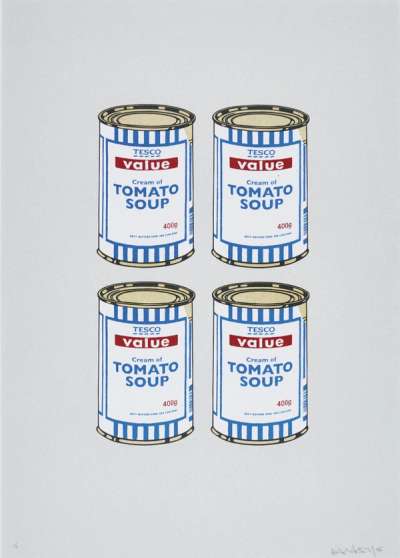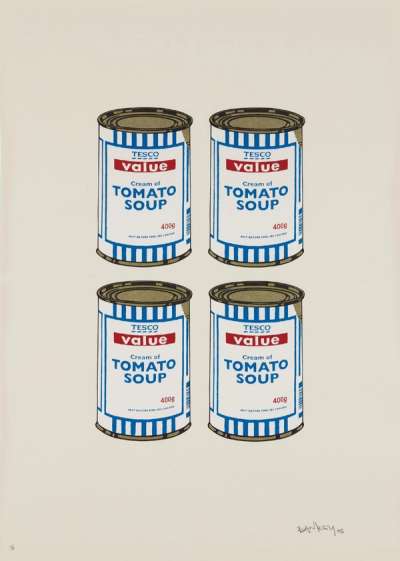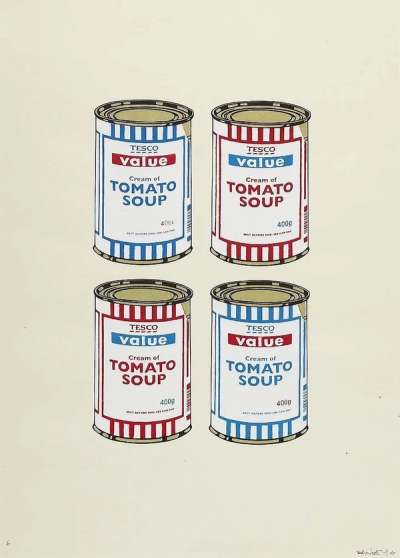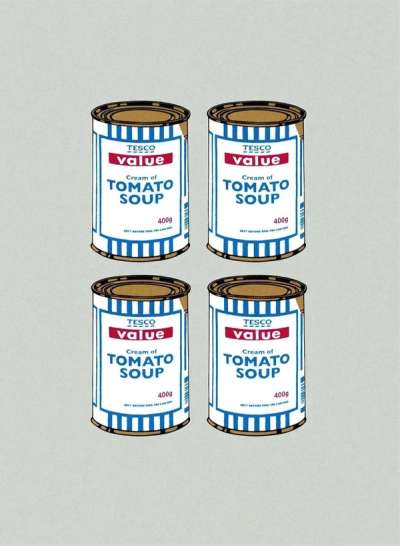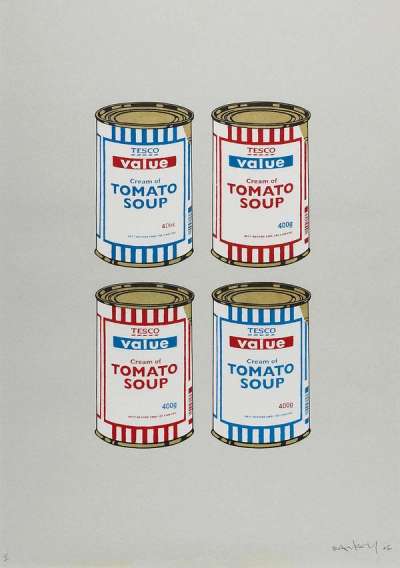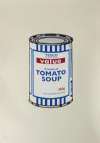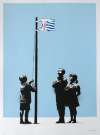Soup
Cans (Quad)
In Soup Cans (Quad), Banksy reimagines Andy Warhol's masterpiece for the disillusioned contemporary viewer. Depicting a Tesco Value soup, he mocks the corporations that drive wealth inequality and criticises the outcome of the consumerism Warhol championed. Banksy repeats the image four times, but in only one flavour, emphasizing poverty’s lack of choice.
Banksy Soup Cans (Quad) For sale
Soup Cans (Quad) Value (5 Years)
Works from the Soup Cans (Quad) series by Banksy have a strong market value presence, with 25 auction appearances. Top performing works have achieved standout auction results, with peak hammer prices of £80000. Over the past 12 months, average values across the series have ranged from £30000 to £50000. The series shows an average annual growth rate of 16.25%.
Soup Cans (Quad) Market value
Auction Results
| Artwork | Auction Date | Auction House | Return to Seller | Hammer Price | Buyer Paid |
|---|---|---|---|---|---|
 Soup Cans Quad (cream paper) Banksy Signed Print | 19 Sept 2024 | Phillips London | £23,800 | £28,000 | £40,000 |
 Soup Cans Quad (gold on grey) Banksy Signed Print | 7 Dec 2020 | Forum Auctions London | £68,000 | £80,000 | £100,000 |
 Soup Cans Quad (blue and red on cream) Banksy Signed Print | 28 Jan 2015 | Bonhams New Bond Street | £7,650 | £9,000 | £11,000 |
 Soup Cans Quad (red and blue on grey) Banksy Signed Print | 28 Jan 2015 | Bonhams New Bond Street | £7,225 | £8,500 | £10,000 |
Sell Your Art
with Us
with Us
Join Our Network of Collectors. Buy, Sell and Track Demand
Meaning & Analysis
Like his Soup Can, Banksy’s 2006 print Soup Can Quad directly references Pop Artist Andy Warhol, as well as themes of poverty and mass production.
Though it could be interpreted as a playful homage to Warhol's Campbell’s Soup series, Banksy’s Soup Cans Quad can also be read as a cutting comment on the rampant rise of poverty in recent times. Satricial in remit, the work also engages with the ever increasing presence of large corporations in contemporary society. While Warhol’s cans depicted a range of flavours – from clam chowder to chicken noodle – Banksy chooses to show just four identical cans of cream of tomato soup. This choice, some have noticed, represents the day-to-day reality- and gastronomic monotony - suffered by those who struggle to survive in poverty. A key feature of Banksy's cans is their gold tops, which gesture towards the value these commodites might hold for a select number of shareholders, who reap financial reward in the form of profit.
Soup Can Quad was originally published in 2006 as a screen print. It came in two different varieties: 54 prints on cream paper and 12 on grey paper, all signed by the artist. The first manifestation of Banksy’s soup cans appeared in 2005 when he released 310 prints of a single can on a cream background, followed by 280 prints in 28 different colourways.
Unlike many other Banksy prints, the soup cans do not derive from an in situ work painted by Banksy in the street. However, they are closely related to the artist's mural, entitled Very Little Helps, which references the Tesco slogan ‘Every Little Helps’. One of Banksy’s most famous murals, it remains preserved on Essex Road in London, now covered by Perspex.
